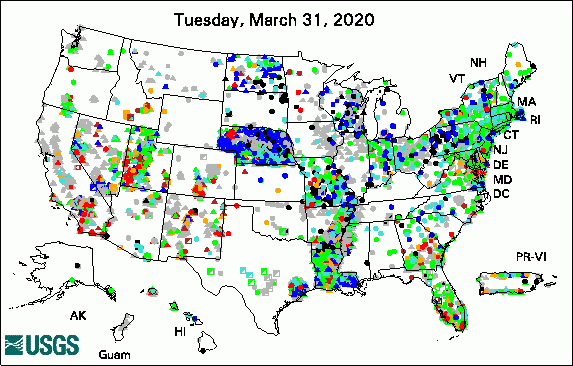USGS Monthly Groundwater News and Highlights: May 1, 2020
Subscribe to get the latest USGS groundwater news and science sent to your inbox every month!
Feature: Estimated Groundwater Withdrawals from Principal Aquifers in the United States, 2015
![Graph showing withdrawals by cateogry of use. [Graph showing withdrawals by cateogry of use. Refer to report for description and numbers. ]](images/feature/2020-05_circ1464_fig2.png)
Groundwater withdrawals in 2015 by category of use from principal aquifers in five major lithologic groups in the United States. Source: Figure 2, Lovelace and others, 2020.
How much groundwater is withdrawn in the United States, and what is it used for? A new USGS report estimates groundwater withdrawals and use in 2015 for the Principal Aquifers of the United States. In 2015 in the United States:
- About 84,600 million gallons per day (Mgal/d) of groundwater were withdrawn.
- 94% of total groundwater withdrawals were from 66 principal aquifers.
- Groundwater was the source of more than 98% of self-supplied domestic water used.
- The High Plains aquifer was the most heavily pumped principal aquifer, accounting for almost 15% of all groundwater withdrawals.
- Fresh groundwater withdrawals from the Mississippi River Valley alluvial aquifer for public supply, irrigation, and industry increased about 27% between 2000 and 2015.
- 91% of groundwater withdrawals from Central Valley aquifer system were for irrigation.
To learn more, download the new report.
Water Quality and COVID-19
For the latest federal guidance on water quality and COVID-19, please refer to:
USGS priority is to continue the important work of the Department of the Interior and the USGS, while also maintaining the health and safety of our employees and community. Based on guidance from the White House, the CDC, and state and local authorities, we have shifted our operations to a virtual mode and have minimal staffing within our offices. These changes have also impacted recent and planned field work and field data collection activities.


The USGS Active Groundwater Level Network includes about 20,000 wells that have been measured by the USGS or USGS cooperators at least once within the past 13 months. The animation shows a daily snapshot of water-level statistics in the network for April 2020. Credit: USGS. The image is in the public domain.
USGS Groundwater-Related Publications
The importance of U.S. Geological Survey water-quality super gages (04/28/20)
Estimated groundwater withdrawals from principal aquifers in the United States, 2015 (04/28/20)
Chemical evaluation of water and gases collected from hydrothermal systems located in the central Aleutian arc, August 2015 (04/27/20)
Groundwater quality in the Redding-Red Bluff shallow aquifer study unit of the northern Sacramento Valley, California (04/30/20)
Mitigating land subsidence in the Coachella Valley, California, USA: An emerging success story (04/23/20)
Detection and measurement of land subsidence and uplift using interferometric synthetic aperture radar, San Diego, California, USA, 2016-2018 (04/29/20)
Potentiometric surface and hydrologic conditions of the South Coast aquifer, Santa Isabel area, Puerto Rico, March-April (04/30/20)
PFAS in the environment (04/17/20)
Updated study reporting levels (SRLs) for trace-element data collected for the California Groundwater Ambient Monitoring and Assessment (GAMA) Program Priority Basin Project, October 2009-October 2018 (04/20/20)
Passive sampling of groundwater wells for determination of water chemistry (04/16/20)
Benthic vertical hydraulic gradients in Upper Klamath Lake, Oregon, 2017 (04/16/20)
Characterization of surface-water and groundwater quality on the Fort Berthold Reservation, North Dakota, 2014-17 (04/13/20)
Viral, bacterial, and protozoan pathogens and fecal markers in wells supplying groundwater to public water systems in Minnesota, USA (04/21/20)
Groundwater chloride concentrations in domestic wells and proximity to roadways in Vermont, 2011-2018 (04/13/20)
The relation of geogenic contaminants to groundwater age, aquifer hydrologic position, water type, and redox conditions in Atlantic and Gulf Coastal Plain aquifers, eastern and south-central USA (04/08/20)
Rio Grande transboundary integrated hydrologic model and water-availability analysis, New Mexico and Texas, United States, and northern Chihuahua, Mexico (04/09/20)
Hydrogeologic framework and simulation of predevelopment groundwater flow, eastern Abu Dhabi Emirate, United Arab Emirates (04/08/20)
One-Water Hydrologic Flow Model: A MODFLOW based conjunctive-use simulation software (04/17/20)
Hydrogeology and shallow groundwater quality in the tidal Anacostia River watershed, Washington, D.C. (04/03/20)
Geophysical surveys, hydrogeologic characterization, and groundwater flow model for the Truxton basin and Hualapai Plateau, northwestern Arizona (04/07/20)
Groundwater quality in the Columbia Plateau Basaltic-Rock Aquifers, northwestern United States (04/01/20)
Groundwater quality in the High Plains Aquifer (04/01/20)
Hydrologic monitoring networks in the Death Valley Regional Flow System, Nye County, Nevada and Inyo County, California (04/07/20)
Simulation of groundwater-level changes from projected groundwater withdrawals in the Truxton basin, northwestern Arizona (04/03/20)
Hydrogeologic characterization of the Hualapai Plateau on the western Hualapai Indian Reservation, northwestern Arizona (04/07/20)
Gravity surveys and depth to bedrock in the Truxton basin, northwestern Arizona (04/03/20)
Geology and hydrology of the Truxton basin and Hualapai Plateau, northwestern Arizona (04/03/20)
Groundwater availability in the Truxton basin, northwestern Arizona (04/06/20)
USGS Groundwater Flow and Transport Model Data Releases
MODFLOW-2005 Groundwater Flow Model to Simulate Predevelopment Groundwater Flow in the Eastern Abu Dhabi Emirate, United Arab Emirates
Field Photo
This month's field photo is a throwback to the past! This photo is of a hydrologist collecting groundwater samples in California in 1917. When Congress created the USGS in 1879, the new organization was made responsible for the scientific "classification of the public lands and examination of the Geological Structure, mineral resources and products of the national domain." Although many people associate the early USGS only with mapping and mining of the West, the USGS was studying groundwater as early as the 1890s! Today, the USGS National Water Information System includes information from more than 900,000 groundwater sites around the Nation.
![Hydrologist collects samples from groundwater well, 1917 [Photo: Hydrologist working at a well]](images/field/2020-05_1917-well-sampling-California.jpg)
Credit: USGS. Photo is in the public domain. Click on photo for larger version.
![Graph showing withdrawals by cateogry of use. [Graph showing withdrawals by cateogry of use. Refer to report for description and numbers. ]](images/feature/2020-05_circ1464_fig2.png)

